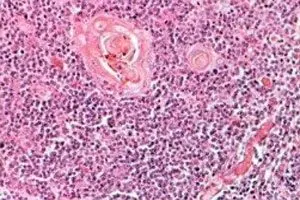Contents

Lymphopenia is a temporary or permanent decrease in the level of lymphocytes in the blood to a level of 1500 / mm3 and below. If lymphopenia is present in a person for a long period of time, then this can lead to the development of an opportunistic infection. By itself, lymphopenia indicates a pathological process in the body, which can be very serious, up to oncology.
Lymphocytes are white blood cells, which are a type of white blood cell. They act as elements included in the overall structure of immunity. Lymphocytes are present in the blood on an ongoing basis. These cells are located in the lymph nodes, in the thymus, in the spleen, in the lymphoid tissue of the intestinal walls and in the bone marrow.
Symptoms of lymphopenia
Lymphopenia is not an independent disease, therefore, there are no specific symptoms of a decrease in the level of lymphocytes in the blood.
Common symptoms of infection entering the body are fever, pallor of the skin, erosion and ulceration of the mucous membranes of the oral cavity and intestines. The patient will experience weakness and malaise, his performance decreases. If lymphopenia is persistent, then the person will suffer from frequent infections that are difficult to treat. With a significant decrease in the level of lymphocytes in the blood, the development of severe complications, up to sepsis and death, is possible.
Causes of lymphopenia

The causes of lymphopenia can be identified as follows:
Severe viral infection. If a person suffers from any disease for a long time, then the reserve reserves of immune cells will eventually be depleted. After temporary lymphocytosis, the patient will experience an acute deficiency of lymphocytes in the body. If treatment is started on time and the infection can be eliminated, then the level of these cells will recover. When there is no treatment, a person can die from complications of the disease due to the failure of the immune system.
Depletion of bone marrow reserves. Some diseases cause depletion of bone marrow reserves. In this case, a person will suffer not only from lymphocytopenia, but also from a deficiency of all blood cells, since it is this organ that is primarily responsible for their growth and development.
Such diseases include:
Anemia Fanconi. This is a congenital disease that is accompanied not only by lymphopenia, but also by a decrease in the level of red blood cells, platelets and all white blood cells. In this case, birth defects are often observed: the absence of thumbs on the hands, short stature, hearing loss. Patients die from severe infections or massive bleeding. There is also a high risk of developing cancerous tumors. Therapy is possible, but a complete cure cannot be achieved unless a bone marrow transplant is performed.
Radiation effect on the body. Irradiation occurs during a combination of adverse circumstances, or can be targeted, during the course of a treatment course. The bone marrow, when exposed to radiation, begins to be replaced by connective tissue. It is unable to reproduce blood cells, which leads to the development of lymphopenia. In parallel, the level of all blood cells falls.
Taking certain medications. Drugs that can provoke the development of lymphopenia include antipsychotics and cytostatics. A decrease in the level of lymphocytes is indicated in the instructions for their use as a side effect. Relative lymphopenia can be caused by corticosteroid therapy, and the level of neutrophils is often reduced to critical levels.
terminal stage heart and kidney failure.
Lymphogranulomatosis. In Hodgkin’s lymphoma, abnormal cells are located in the lymph nodes. In this case, they increase in size, the patient develops anemia, and the likelihood of bleeding increases. At night, a person is worried about sweating, he begins to lose weight, his body temperature rises. Painful sensations will be caused by the pressure of the growing tumor on the tissue.
immunodeficiency condition. Immunodeficiency states can develop during life or be congenital pathologies. If there is a deficiency of T-lymphocytes, then this can be detected using a routine blood test. When there is a decrease in the number of B-lymphocytes, additional methods of examination are required.
These states include:
DiGeorge syndrome (thymus hypoplasia). At the same time, the child has congenital anomalies in the development of the facial bones, heart defects, cleft palate, etc. The severity of lymphocytopenia depends on the degree of damage to the thymus.
Severe combined immunodeficiency. This disease is genetic. It damages both cellular and humoral immunity. The child will begin to suffer from manifestations of pathology almost from birth. Serious illnesses with serious complications (pneumonia, sepsis, skin infections, etc.) come to the fore. Even the most harmless diseases can lead to the death of a child.
AIDS. The human immunodeficiency virus enters the body and begins to infect T-lymphocytes. Infection occurs either during the mixing of the biological fluids of a sick and healthy person, or during pregnancy and childbirth, when the virus is transmitted from mother to child. The first symptoms will appear several years after infection. Lymphopenia will progress, the body will cease to fight infections on its own, the likelihood of developing sepsis and death increases. The risk of developing oncological diseases also remains high, since T-lymphocytes fighting cancerous tumors will be destroyed by the virus.
Diagnosis of lymphopenia

To diagnose lymphopenia, a person needs to see a general practitioner. The doctor will order him to take a clinical blood test. In the laboratory, a doctor can observe lymphocytes on a blood smear by staining them with Romanovsky’s dye. Lymphocytes have a transparent cytoplasm inside which there is a dense nucleus. Depending on the amount of cytoplasm, small and large lymphocytes are distinguished. Normally, a liter of adult blood contains 1,5-4,0 * 109 lymphocytes. If their number is lower, then we can talk about lymphopenia.
After this fact is established, it is necessary to determine the reasons that provoked this violation. To do this, the doctor will refer the patient for an additional examination, which will clarify the diagnosis and prescribe treatment.
Treatment of lymphopenia

Lymphopenia does not imply any specific treatment, since this condition is not an independent disease. To increase the level of lymphocytes to normal values, it is necessary to eliminate the cause that caused such a violation. After that, the level of lymphocytes in the blood will return to normal on its own.
To rid the patient of severe inflammatory reactions and to improve the quality of the blood, he is prescribed immunoglobulins G. The dose is calculated based on the formula of 0,4 g of immunoglobulin per kilogram of weight. The drug is administered once every 7 days.
It is necessary to refuse the use of immunoglobulins with the development of severe adverse reactions. Treatment with immunoglobulins can provoke a sharp decrease in blood pressure, collapse or allergic reactions. When a person has congenital diseases and it is they who cause lymphopenia, immunoglobulins are not used for treatment.
To get rid of Fanconi anemia, the patient will need a bone marrow transplant. Temporary relief and delay of complications is possible by taking glucocorticosteroids. The average life expectancy for people with Fanconi anemia is 30 years.
If lymphopenia was provoked by taking medications, then, if possible, such therapy should be abandoned. After some time, the level of lymphocytes will be restored.
If lymphopenia is caused by lymphogranulomatosis, then the patient is prescribed cytostatics with further radiation exposure to the lymph nodes. Provided that a relapse occurs, the patient is prescribed aggressive chemotherapy and waiting for a bone marrow donor to transplant it. As a rule, about 85% of such patients overcome the five-year survival limit. The prognosis is less favorable when the disease is diagnosed at the terminal stage, or the patient’s age exceeds 45 years.
DiGeorge syndrome in a child requires either a thymus or bone marrow transplant. This is especially true for patients with complete rather than partial syndrome. If such treatment is absent, the patient will die from infectious diseases.
Severe combined immunodeficiency is treated only with a bone marrow transplant. If the operation is performed in the first 3 months of a child’s life, then there is a chance for a complete recovery of the baby. When there is no treatment, then children do not live longer than 2 years.
HIV infection requires antiretroviral therapy. This allows you to contain the disease and prolong the life of a person. Complete elimination of HIV is currently impossible.
Doctors and parents should be especially vigilant when the level of lymphocytes is reduced in a small child. Normally, the levels of these blood cells in children are even higher than in adults. Therefore, lymphopenia in a child should be the reason for checking the allergic status of the baby or diagnosing congenital diseases.
Lymphopenia requires a comprehensive examination of the patient. If you ignore this symptom, you can miss the time and not notice how a dangerous disease develops in the body. After all, lymphocytes are the most important cells that are responsible for the formation of the human immune system. Therefore, if any complaints and symptoms of malaise appear, it is necessary to consult a doctor to take a blood test.









